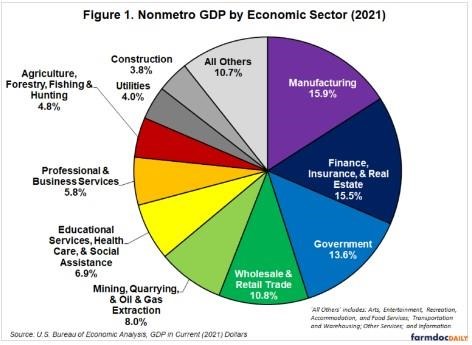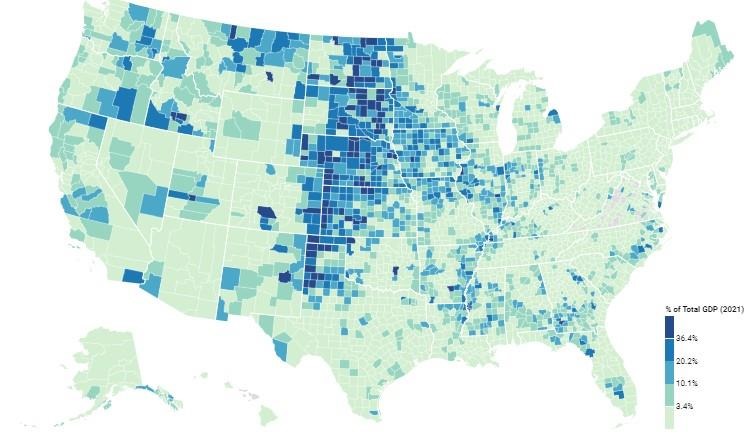By Mark White
Department of Agricultural and Consumer Economics
University of Illinois
Agriculture is a highly visible and important economic activity in many parts of rural America. The U.S. Bureau of Economic Analysis’ annual estimates of county-level Gross Domestic Product (GDP) —most recently released in December 2022—provide one way to measure those contributions for individual counties and nonmetropolitan regions more generally. GDP represents the total value of goods and services produced in a place, and these data offer a detailed picture of the geographic distribution of economic activity across the U.S. (Guci, Mead, and Panek 2016). Below we use GDP to show the importance of production agriculture to local economies.
Nonmetro Counties Make Significant Contributions to the Agricultural Sector, But the Sector Remains Relatively Small
Agriculture, Forestry, Fishing and Hunting (NAICS 11)[1]—hereafter referred to production agriculture—accounted for $206.6 billion of the U.S. economy in 2021 (0.9% of the total U.S. GDP).[2] Although nonmetropolitan counties[3] generated only 10% of total U.S. GDP, these counties contributed over half (52.3%, or $108.1 billion) of GDP created from production agriculture. Over the past two decades, the share of GDP created by the sector has been split relatively evenly between metro and nonmetro counties with the latter producing a slight majority almost every year since 2008.
Production agriculture is one of many sources of economic activity in nonmetro counties. Figure 1 shows that production agriculture generated 4.8% of the total 2021 GDP in nonmetro countries. This sector was the 8th largest behind other sectors such as manufacturing (15.9%); Finance, Insurance and Real Estate (15.5%); and Government (13.6%), the latter of which also includes public school employees (K-12 and post-secondary).

Using inflation-adjusted estimates, the annual GDP generated by the nonmetro production agriculture sector has grown by almost 50% since 2001.[4] As a share of total nonmetro GDP, however, the agricultural sector has remained between 5% and 6.5% over the past two decades. During this time, other sectors grew at a faster pace, notably professional and business services (80%) and mining (65%).
Nonmetro Economies Are Diverse, and the Agricultural Sector Dominates Some Rural Areas
Production agriculture’s economic importance is not consistent across nonmetro counties. U.S. BEA’s county-level GDP estimates (Figure 2) show the relative contributions that production agriculture makes to each county’s economy. The agricultural sector is a leading source of economic activity for many counties located in the Great Plains (e.g., Eastern Montana, the Dakotas, Nebraska, Eastern Colorado, Western Colorado and the Texas and Oklahoma Panhandles) and in parts of the Midwest (e.g., Iowa, Central Illinois, Northern Missouri).

In many instances, the counties where production agriculture represented the greatest share of GDP have relatively smaller populations and more limited sources of other economic activity. Production agriculture generated more than 20% of total GDP in 323 counties nationwide; 262 of these counties (82%) had 10,000 or fewer residents.[5] In the five counties where the agricultural sector accounted for more than 70% of total county GDP, all had fewer than 3,000 residents and three—Hayes, Banner, and Wheeler counties in Nebraska—had fewer than 1,000 residents.
Production agriculture was the leading source of economic activity in some larger counties, but these were fewer in number. For instance, the sector was the primary source of GDP in just 19 counties with populations larger than 20,000. The largest of these counties were in California, including Tulare (Ag. 18.4% of GDP, Pop. 477,054), Monterey (Ag. 18.7% of GDP, Pop. 437,325), and Madera (Ag. 23.6% of GDP, Pop. 159,410). In these instances, the counties are both large geographically and demographically, and they also tend to have more diverse economies.
Moreover, their agricultural sectors often produce higher value crops. For instance, Tulare County is one of the nation’s leading producers of milk, oranges, and almonds, Monterey County is leader in lettuce and broccoli, and Madera County produces large amounts of almonds and pistachios. Where agriculture was the leading source of economic activity in more mid-sized counties, similar trends occurred. For example, the agricultural sector in Sampson County in North Carolina (Ag. 18.2% of GDP, Pop. 58,990) is driven in part by hog and turkey production, as well as tobacco; Hendry County, FL (Ag. 25.5% of GDP, Pop. 40,313) produces citrus fruit and sugar cane.[6]
Diverse Regional Economies Can Support the Agricultural Sector
County-level GDP measures can provide some insight into local economic diversity. In many nonmetro counties, production agriculture plays a complementary role that supports the local and regional economy. By contrast, where the sector generates an outsized portion of the county’s GDP these places may possess potential economic vulnerabilities when market challenges or natural disasters arise (e.g., derecho, drought, flooding, etc.). In these instances, local economic development goals should not be creating diversity for diversity’s sake, but rather establishing and supporting multiple sources of economic growth to mitigate these risks and to create new economic opportunities (Feser et al. 2014).
Ultimately, many rural communities need more diverse economies to support their agricultural activities. A recent report—sponsored by CoBank—showed that 82% of farm household income came from off-farm sources (Spell et al. 2022). This income does not just come from spousal jobs, as 56% of principal farm operators in 2017 had a main job off the farm. These off-farm jobs provide farm operators with additional income and access to benefits like health insurance. As a result, these off-farm employment opportunities may allow many farmers and their families to continue participating in production agriculture. A stronger understanding of what drives local and regional economies can enable rural community leaders to develop and advocate for strategies that strengthen and diversify their local and regional economies.
Source : illinois.edu